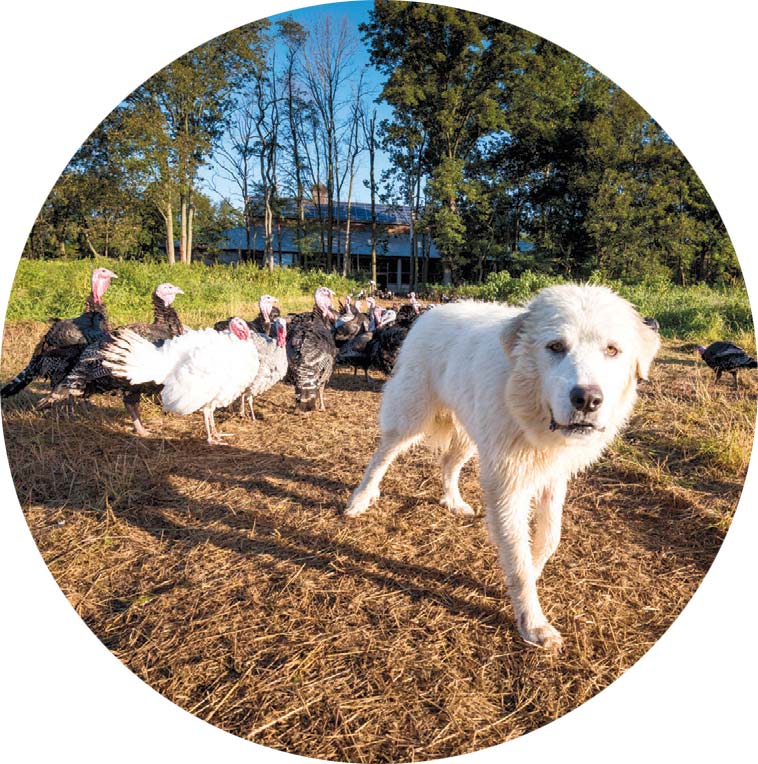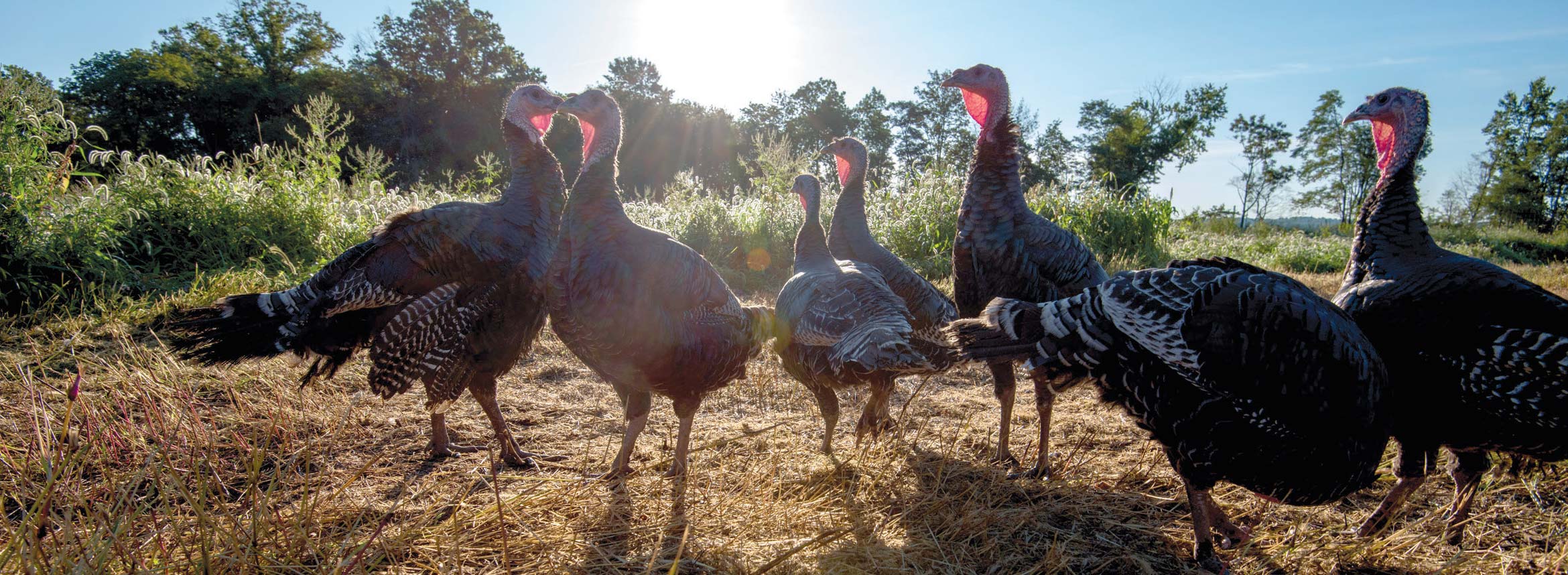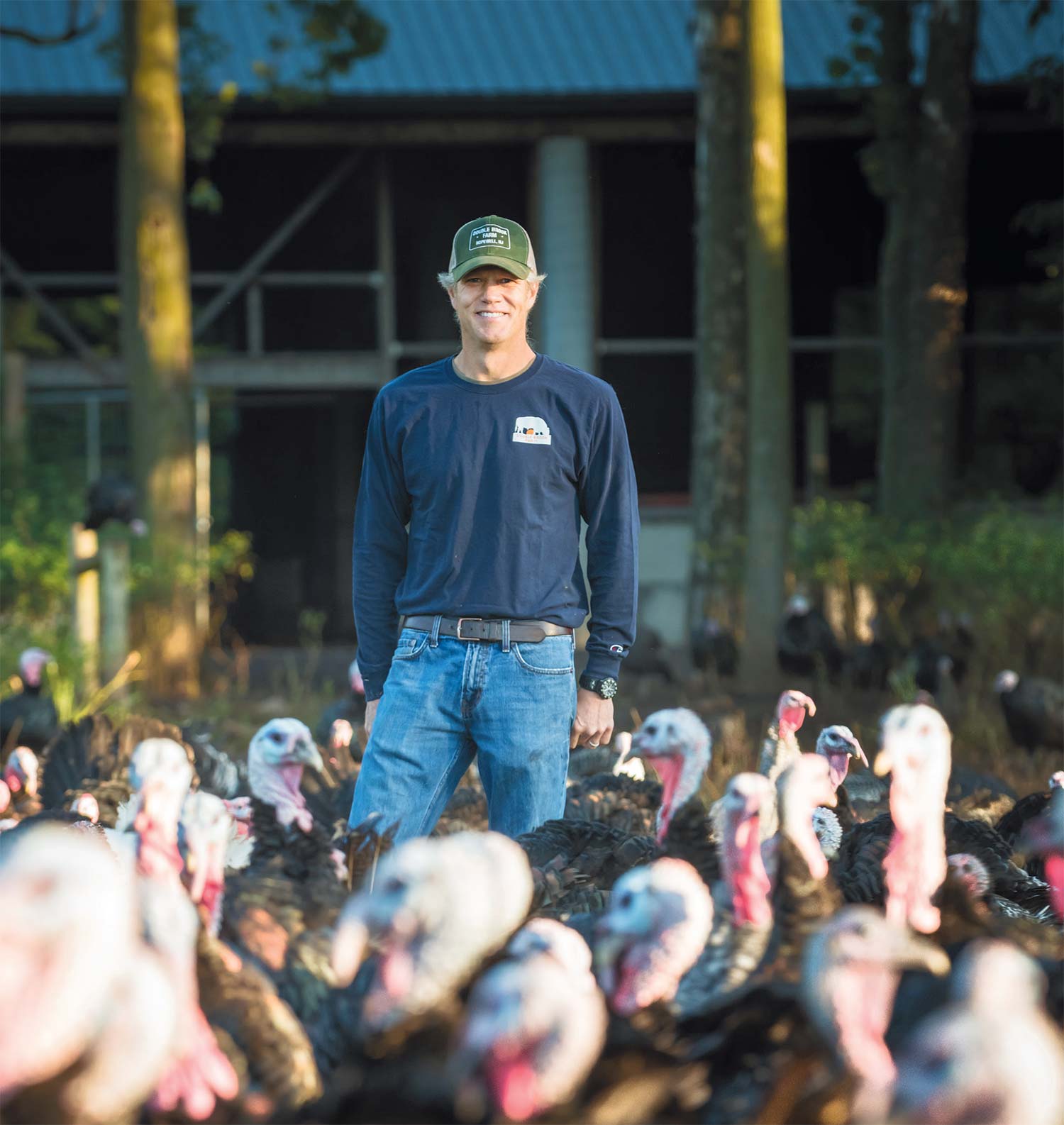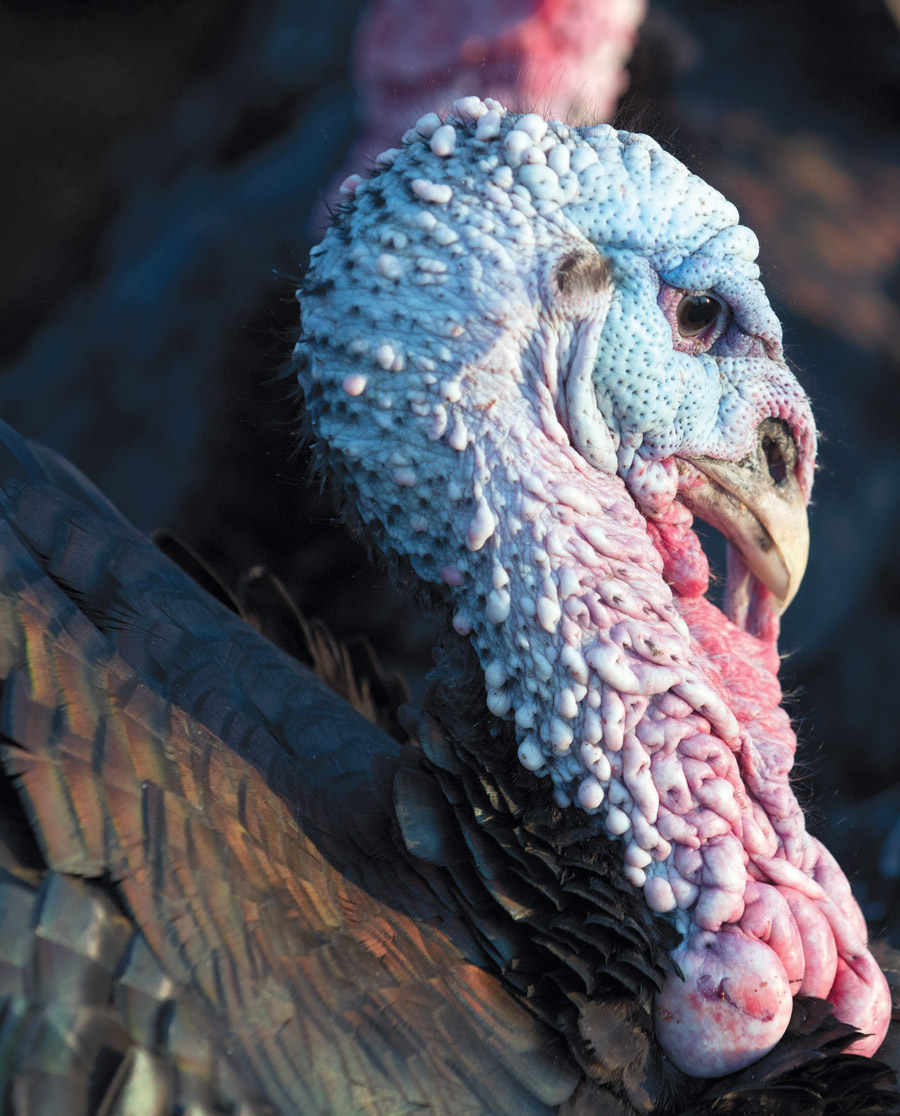Heritage Turkeys
Double Brook Farm turns to an old-school model
Most farmers view a patch of ragweed as both a nuisance and a liability. Not Jon McConaughy. As the owner of Double Brook Farm in Hopewell, he sees that ubiquitous native plant as an essential ingredient for a tasty Thanksgiving meal.
“Turkeys love ragweed,” McConaughy says. “So, something that other farms are trying to get rid of—and that occurs naturally—is good for our farm. It’s high in protein and something that a wild turkey has always had in its diet. The heritage breed turkeys pick up on that and it becomes a benefit as opposed to a detriment.”
Using ragweed as animal feed is just one example of McConaughy’s unconventional approach to raising turkeys—an approach that integrates multiple goals of flavor, environmental restoration and humane farming.
Today’s typical American Thanksgiving turkey has traveled light years from its wild roots. Of the 243 million turkeys slaughtered in the United States in 2016, most were the broad-breasted white. Bred to meet the needs of industrial-scale production, the modern broad-breasted white is so large that it can no longer mate naturally or fly. Its rapid growth leads to health problems, which the Poultry Science Association enumerates to include heart disease, skeletal problems, and increased susceptibility to certain pathogens. To make more efficient use of feed, the space allowed for each bird is restricted in order to limit calorie-expending movement.
All of these factors, McConaughy says, diminish the quality of the meal.
“The problem is that there is no flavor. Part of the flavor that you get out of the heritage turkey is that it takes so long to grow that you have more mature muscle mass. Part of it is that they are in movement—and there is flavor that goes along with movement. And part of it is the breed itself.”
When McConaughy and his wife and co-owner, Robin, began raising turkeys in 2008, they naturally gravitated toward heritage breeds. “What animal diversity could we add that would be symbiotic, good for the land and add to our business? Turkeys were a natural fit,” McConaughy says. “We chose heritage turkeys because we realized they thrived on pasture, tasted better and were cheaper in the long run because they had better health, which is the reason we have all our breeds. The industrial turkeys are bred for three main purposes; feed efficiency, speed of growth and size of final product. Those birds do not do well outside.”
The first year, they purchased 40 poults (turkey chicks). The second year, they purchased 100. By the time their store, Brick Farm Market, opened in 2013, they were up to 600 birds. In 2017, that number increased to 1,300 and includes four heritage breeds—white Holland, slate, black Spanish and bronze. (Heritage has no standard definition. The Livestock Conservancy defines heritage turkey breeds as being able to mate naturally, have a long, productive outdoor lifespan and a slow growth rate.)
McConaughy first purchased poults from commercial turkey hatcheries, but found that at maturity those birds were quite small. “The bourbon reds that we initially got were tiny,” McConaughy says. “Even the toms, which are the ones that are supposed to get big, barely made it over 15 pounds live, which is a very small turkey.” In 2013, he began to buy poults from Frank R. Reese Jr., owner of Good Shepherd Poultry Ranch in Kansas. One of the nation’s most respected poultry farmers, Reese has been raising heritage turkeys and chickens since the 1950s. According to his website, his ranch is home to the nation’s oldest flock of pure, standard-bred poultry.
“He is truly one of the few people in the United States who is focused on raising the right breeds in the right way,” says McConaughy.
Reese won’t just sell his birds to anyone who places an order. Before McConaughy could buy birds from him, he had to pass a farm inspection and interview by a representative of Good Shepherd Farm to ensure that he would not confine or mistreat the birds. The first year, McConaughy and a companion flew out to Kansas, rented a minivan, loaded it with 500 poults and drove 22 hours straight back to New Jersey. Stone Barns Center for Food and Agriculture in Pocantico Hills, NY, had also passed the interview process, and McConaughy brought birds back for them, too. The next year he brought back birds for Double Brook, Stone Barns, and the Farm at Glenwood Mountain in Sussex. “And then the following year was the same,” McConaughy says. “I brought back birds for everybody the next year. I was the bird guy.”
While traveling to the American heartland to buy heritage turkeys may sound romantic, keeping the birds comfortable on the trip home meant that open windows and a separate cargo compartment were not an option. “It’s fairly loud and becomes a fairly smelly trip. You are in the same cabin as the turkeys because you have to keep them at a certain temperature,” McConaughy says. “The first year, we didn’t really know what to expect. We rented a van and I was very concerned that they were not going to take the van back because of the odor.”
“When you’re trying to fix flavor or what’s good
for us or what’s good for the animal or what’s
humane or what’s good for the environment,
the reality is that, in most cases, if you
try to fix one of those things
you get all the rest of the package deal.”
—Jon McConaughy, Double Brook Farm
The following year, McConuaghy did the entire drive alone. In the years after that, he was met halfway. “We would do the exchange in the parking lot, which was kind of funny if you were a bystander, as we were switching turkeys over in the parking lot of the Best Western.”
In addition to getting better birds, McConaughy’s trips to Reese’s farm exposed him to a method of raising turkeys that has defined the way turkeys are raised on Double Brook Farm. “Watching how he lets the birds be in nature and what that whole process looked like was very important to how we ultimately ended up doing it,” McConaughy says. “What I learned from Frank is that there is a natural tendency for a turkey to come home.”
At Double Brook Farm, the turkeys spend each night in a large, open-air barn. Each morning, the doors are opened and the flock is free to wander within five fenced acres where they feed on insects, ragweed and other plants—including sorghum that is planted specifically for them. They can also return to the barn at any time during the day to access feed made from local, non-GMO corn and soy. In the evening, the birds return to the barn to roost.
“Depending upon their age, we’ll close the barn gates at night just to keep other things out,” McConaughy says. “As they get older and they are all roosting up in the rafters, we don’t need to close the doors.”
The “things” that need to be kept out are predators, which include raccoons, foxes, coyotes, weasels and the occasional groundhog. “Raccoons are probably the biggest threat because they are so incredibly smart. They can figure out how to get into anything,” McConaughy says. “They’ll kill 20, 30, 40 birds a night.”
Every few days, the Double Brook crew mows a path through the thickest sections of weeds. Mowing gives the turkeys easier access to bugs and plants. It also facilitates one of McConaughy’s favorite pastimes—sitting among the turkeys.
“Turkeys, I would have to say, are my favorite animal because they are so curious,” McConaughy says. “There is something sort of magical about going and sitting with the turkeys. They all come over and surround you and then they all start to chat to each other. You can take your lawn chair and sit among them for an hour and sort of meditate as they are talking away.”
This year, McConaughy took on the added challenge of breeding and incubating poults on the farm—a practice that was once commonplace on American farms. Several factors drove that decision. The logistics of delivering birds from the Midwest to multiple Eastern farms was proving to be more and more difficult as demand for these birds grew. Cost was also an issue—both in dollars and in lives. Even when accounting for the cost of incubators, additional labor and feeding the breeding stock over the winter, McConaughy calculates that it costs him less than $1 per bird to hatch his own poults. Reese’s poults and the hatchery’s poults, which are shipped via the US mail, cost between $11 and $13 apiece delivered—and that is before taking into account the cost of the birds that die in transit.
“We expect to lose 10 to 20% of the birds that we get through the mail or from Frank,” McConaughy says. “Of the birds that we hatched out, we lost about 1%.” Along with the poults that die in transit, investigative films such as the Humane Society of the United States’ expose on the Wilmar Poultry Company in Minnesota, the nation’s largest turkey hatchery, also indicate that an unnerving number of injured or unneeded birds are killed at the hatchery.

The Animal Welfare Institute points to other disturbing practices at industrial hatcheries. “It is standard practice to perform painful mutilations such as beak, toe and snood (part of the waddle) removal to prevent turkeys from injuring or cannibalizing each other in the intensely crowded quarters. High mortality rates are common; millions of turkeys die on the farm before they can be sent to slaughter.”
McConaughy began his breeding program by holding back 20 black Spanish turkeys from his 2016 flock. Three of those birds were killed by raccoons. The remainder produced about one-third of the poults in his 2017 flock. This fall, he will hold back 100 hens and five toms in hopes of increasing his on-farm incubation to 75% percent of next year’s flock.
When choosing breeds, McConaughy prioritizes flavor, which is why he is focusing his on-farm breeding on black Spanish. “The Spanish blacks are the ones that have the richest flavor,” McConaughy says. “I haven’t heard it described any other way except that it tastes more turkey-ey.”
Unlike mechanized harvesting, which is standard practice in the slaughter stage of industrial turkey production, Double Brook’s turkeys are harvested by hand on the farm. The turkeys are then air cooled to preserve flavor and ensure that the only moisture in the meat is natural.
About half of this year’s flock will be pre-sold for Thanksgiving. The remaining birds will go into lunchmeat, ground turkey and dishes that are served at the market and at Brick Farm Tavern, the McConaughys’ restaurant. The ground turkey will soon be used for turkey burgers at the Red Barn Milk Company, their new South Ringoes—based burger and ice cream collaboration with Hun-Val Dairy.
At $6.50 per pound, Double Brook has to compete in a retail marketplace that has long treated Thanksgiving turkeys as an inexpensive enticement to get shoppers into stores. “It is extremely cheap to raise those commercial turkeys. So there are some challenges when you’re talking about a commercial turkey versus the heritage turkey,” McConaughy says. “But we have a client base that is willing to pay the extra price. The flavor difference as well as the health difference as well as the humane difference that goes along with heritage turkey is important to them.”
Along with improving their holiday meals, Double Brook’s customers are supporting McConaughy’s efforts to find a difficult balance between producing sufficient food and farming in a way that enriches and heals the environment.
“If we’re going to change farming, we need to be able to feed everybody,” McConaughy says. “Even though it can be done right—and be better, in fact beneficial, for the environment—it still has to have production size if we’re going to feed everyone.”
His search for that balance led him to adopt an older model of farming in which a variety of livestock are raised outdoors on pasture. In that model, animals harvest a wide range of naturally occurring plants, which gives them a diverse diet while also improving the soil by stimulating plant growth above and below ground. And keeping the appropriate number of animals per acre means that their manure is enriching the soil, rather than acting as a pollutant. This layered approach to farming—combined with a focus on heritage breeds—yields flavorful meat and dairy while simultaneously encouraging biodiversity and improving soil health.
“There’s a lot of thinking that goes along with the old-school farming,” McConaughy says. “When you’re trying to fix flavor or what’s good for us or what’s good for the animal or what’s humane or what’s good for the environment, the reality is that, in most cases, if you try to fix one of those things you get all the rest of the package deal.”
“But,” he adds, “if economics is the only thing you’re trying to solve, what you’ll get to is our industrial food system.” n
Double Brook Farm turkeys can be ordered at brickfarmmarket.com and doublebrookfarm.com until a week before Thanksgiving.

EDITOR’S NOTE: In NJ, turkeys are raised by a number of farms, including those listed below.
Goffle Road Farms, in Wycoff, and Churutabis Farm, in Branchville, also breed turkeys. Most NJ farms do not.
ASHLEY FARMS
25 Hillside Avenue, Flanders
973.584.7578
ashleyfarmsonline.com
raising turkeys
CHURUTABIS FARM
53 Hyatt Road, Branchville
churutabis.com
raising white turkeys, breeding and raising chocolate turkeys
DEY FARM
215 Dey Road, Cranbury
609.395.0232
raising turkeys
DIPAOLA TURKEY FARM
883 Edinburgh Road, Hamilton
609.587.9311
dipaolaturkeyfarm.com
raising turkeys
DOUBLE BROOK FARM
P.O. Box 96, Hopewell
609.466.3594
doublebrookfarm.com
breeding and raising turkeys
THE FARM AT GLENWOOD MOUNTAIN
1801 County Road 565, Sussex
974.446.0020
thenjfarm.com
raising turkeys
GOFFLE ROAD FARMS
549 Goffle Road, Wyckoff
201.444.3238
gofflepoultry.com
breeding and raising turkeys
GRIGGSTOWN FARM
484 Bunker Hill Road, Princeton
908.359.5218
griggstownfarm.com
raising turkeys
HINCK’S TURKEY FARM
1414 Atlantic Avenue, Manasquan
732.223.5622
hincksfarm.com
raising turkeys
LIMA FARMS
826 Amwell Road, Hillsborough
908.336.8238
limafamilyfarms.com
raising turkeys
SPRING VALLEY TURKEY FARM
402 Spring Valley Road, Old Bridge
732.970.5265
springvalleynj.com
raising turkeys
VERNON VALLEY FARM
99 Sand Hill Road, Sussex
973.209.4829
vernonvalleyfarm.com
raising turkeys

COOKING A HERITAGE TURKEY
Greg Vassos, executive chef and partner at Brick Farm Tavern, prefers heritage breed turkeys because he finds them to be much more flavorful, moist and tender than conventional turkeys. In addition to the more pronounced turkey flavor-a quality which McConaughy describes as the “turkey-ness of a turkey”-the meat is darker and retains more moisture. “Even though the broad-breasted whites have a lot of moisture when they are harvested and when you purchase [them] in the store, because of their muscle fiber and their muscle makeup, it leaves quickly,” McConaughy says. “It’s hard to say that you can’t ruin a heritage bird, but it is a lot harder to ruin than a broad-breasted white. Anybody who’s ever cooked a turkey for Thanksgiving, all the different tricks that they’re going through to try to make it moist, is because the muscle fiber just doesn’t hold moisture the way a heritage breed does.”
In the restaurant, Vassos brines his turkey pieces, cooks them sous vide and then finishes them on the grill or by pan-roasting in brown butter, herbs and garlic. His favorite pairing is Brussels sprouts larded in bacon fat, cranberry compote and potato gratin. For the home cook, Vassos recommends a maple brine followed by roasting at 325°F for 15 minutes per pound. Fifteen minutes before it is done, brush the turkey with a maple-tarragon-mustard glaze. Allow the cooked turkey to rest for half an hour before slicing. Vassos says this results in a moister turkey because if you slice it immediately out of the oven, you lose all of the juice.





